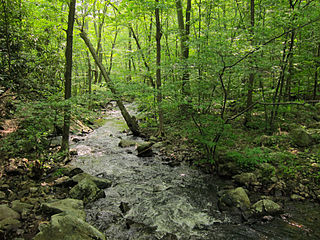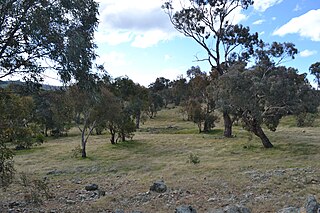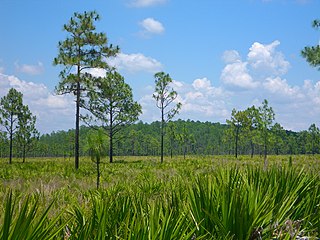Related Research Articles

The Northeastern coastal forests are a temperate broadleaf and mixed forests ecoregion of the northeast and middle Atlantic region of the United States. The ecoregion covers an area of 34,630 sq miles (89,691 km2) encompassing the Piedmont and coastal plain of seven states, extending from coastal southwestern Maine, southeastern New Hampshire, eastern Massachusetts, and Rhode Island, southward through Connecticut, New York State, New Jersey, southeast Pennsylvania, Delaware and Maryland.

The Chavez Ravine Arboretum, in Elysian Park, just north of Dodger Stadium, at 1025 Elysian Park Dr, Los Angeles, California, contains more than 100 varieties of trees from around the world, including what are believed to be the oldest and largest Cape Chestnut, Kauri, and Tipu trees in the United States. Admission to the arboretum is free.

Nichols Arboretum, locally known as the Arb, is an arboretum on the campus of the University of Michigan, in Ann Arbor, Michigan. The Arb is located adjacent to the Huron River, and features over 400 species, including 110 species of trees, in a varied, hilly landscape. A signature feature of Nichols Arboretum is the W. E. Upjohn Peony Garden, which features the largest collection of heirloom peonies in North America.

The Flora of the Australian Capital Territory are the plants that grow naturally in the Australian Capital Territory (ACT). The environments range from Alpine area on the higher mountains, sclerophyll forest, to woodland. Much of the ACT has been cleared for grazing, and is also burnt off by bushfires several times per century. The kinds of plants can be grouped into vascular plants that include gymnosperms, flowering plants, and ferns; bryophytes, lichens, fungi, and freshwater algae. Four flowering plants are endemic to the ACT. Also several lichens are unique to the ACT, however as further study is undertaken they are likely to be found elsewhere too.

The Appalachian mixed mesophytic forests is an ecoregion of the temperate broadleaf and mixed forests biome, as defined by the World Wildlife Fund. It consists of mesophytic plants west of the Appalachian Mountains in the Southeastern United States.

The Appalachian–Blue Ridge forests are an ecoregion in the Temperate broadleaf and mixed forests Biome, in the Eastern United States. The ecoregion is located in the central and southern Appalachian Mountains, including the Ridge-and-Valley Appalachians and the Blue Ridge Mountains. It covers an area of about 61,500 square miles (159,000 km2) in: northeast Alabama and Georgia, northwest South Carolina, eastern Tennessee, western North Carolina, Virginia, Maryland, and central West Virginia and Pennsylvania; and small extensions into Kentucky, New Jersey, and New York.

The New England-Acadian forests are a temperate broadleaf and mixed forest ecoregion in North America that includes a variety of habitats on the hills, mountains and plateaus of New England and New York State in the Northeastern United States, and Quebec and the Maritime Provinces of Eastern Canada.

A cypress dome is a type of freshwater forested wetland, or a swamp, found in the southeastern part of the United States. They are dominated by the Taxodium spp., either the bald cypress, or pond cypress. The name comes from the dome-like shape of treetops, formed by smaller trees growing on the edge where the water is shallow while taller trees grow at the center in deeper water. They usually appear as circular, but if the center is too deep, they form a “doughnut” shape when viewed from above. Cypress domes are characteristically small compared to other swamps, however they can occur at a range of sizes, dependent on the depth.
This is an alphabetical list of useful timber trees, indigenous and exotic, growing in the Gauteng area of South Africa. These trees range in size up to some 1.5m DBH, such as Cedrus deodara, the Himalayan Cedar. Hobbyists will seek out even small pieces of highly valued timber, such as Buxus macowanii, the South African counterpart of Buxus sempervirens, for turnery or the making of boxes and small items. Despite the wealth of useful woods available in Gauteng, most of the trees, felled or fallen, are dumped or cut into short lengths for fuel. Trees grown in urban or suburban environments are rarely pruned and are consequently often knotty. Timber frequently holds nails, wire and spikes, attesting to a variety of abuse during the lifetime of a tree, and requiring the use of a metal detector by the sawmiller. Garden cuttings and dead leaves are occasionally piled next to trees and burnt, leaving charred scars and inclusions.

The Iberian conifer forests is a Mediterranean forests, woodlands, and scrub ecoregion in southwestern Europe. It includes the mountain forests of southern and central Spain.

Rivière-du-Moulin Ecological Reserve is a strictly protected ecological reserve in the province of Quebec, Canada. It contains a stand of mature eastern hemlock trees, with some white pines, a combination that was once common in Quebec but has almost disappeared due to forestry and farming.
References
- 1 2 3 4 Summit, R. and A. Sliker. 1980. Handbook of Materials Science, Volume IV: Wood. Florida: CRC Press, Inc.
- ↑ Distemonanthus benthamianus. Archived 2021-01-18 at the Wayback Machine Wood Technical Fact Sheet. Forest Service. USDA.
- ↑ "Bloodwood | the Wood Database - Lumber Identification (Hardwood)". Archived from the original on 2016-08-03. Retrieved 2016-05-16.
- ↑ "MADERAS DEL". Government of Peru, INIA. 1999. Archived from the original on 14 August 2022. Retrieved 13 August 2019.
- ↑ Diospyros crassiflora. Archived 2015-03-24 at the Wayback Machine Plant Resources of Tropical Africa.
- 1 2 3 4 Denham, R. (1999). "Specialty Timbers for the Western Australian Wheatbelt" (PDF). Farmnote 80/99. Department of Agriculture Western Australia. Archived from the original (PDF) on 9 March 2016. Retrieved 11 August 2012.
- ↑ the editors of Fine woodworking (2003). In the 18th century style: building furniture inspired by the classical tradition. US: The Taunton Press. pp. 36–43. ISBN 1-56158-397-9.
{{cite book}}:|last=has generic name (help) - ↑ Carapa guianensis. Archived 2014-01-09 at the Wayback Machine World Agroforestry Centre.
- ↑ Richter, H. G. and M. J. Dallwitz. 2000 onwards. Brosimum rubescens Taub. Commercial timbers: descriptions, illustrations, identification, and information retrieval. DELTA – DEscription Language for TAxonomy. June 2009.